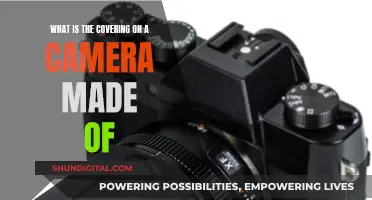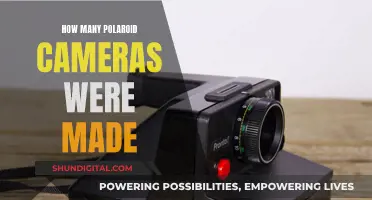
The first Land Camera, also known as the Polaroid Model 95, was the first commercially available instant camera. It was invented by American scientist Edwin Land and unveiled in 1948, a year after he introduced instant film in New York City. The camera produced sepia-toned prints in about a minute and was an instant hit with customers. The Model 95 was the first in a series of innovations by Polaroid that would revolutionise traditional photography and make the company a household name.
What You'll Learn
- The Model 95 Land Camera was the first commercially available instant camera
- Edwin Land's desire for instant photography stemmed from a question by his daughter, Jennifer
- The Land Camera was the result of years of experimentation with crystals, dyes, and polymers
- The camera and film were sold at the Jordan Marsh department store in Boston
- The Model 95 produced sepia-toned images and required precise operation by photographers

The Model 95 Land Camera was the first commercially available instant camera
The Model 95 Land Camera, also known as the Polaroid Land Camera Model 95, was the first commercially available instant camera. It was designed by Dr. Edwin Land and was the first successful implementation of a self-developing 'instant' film camera. The camera was released in 1948 and was the first of Polaroid's instant picture cameras.
The Model 95 was a folding camera for self-processing film packs of 3 1/4 by 4 1/4 inches. It used an early form of instant roll film that would be pulled from the camera one exposure at a time. The development time was a little over a minute, which was slow by later instant film standards but revolutionary at the time. The camera packed the chemistry of a darkroom into a handheld device.
The Model 95 was extremely successful, with over 1.5 million units sold. It was the first of its kind, and the name "Polaroid" became synonymous with instant photography in the second half of the 20th century. The camera's success led to the release of many different models and film formats by Polaroid, with the company reaching its peak popularity in the late 1970s.
Cropping Like a Pro: Camera Raw Secrets
You may want to see also

Edwin Land's desire for instant photography stemmed from a question by his daughter, Jennifer
Edwin Land's desire for instant photography was sparked by a question from his three-year-old daughter, Jennifer, during a family vacation in 1943. She asked him why she couldn't see the photos he had just taken right away. At the time, photographs had to be sent to a lab for development, a process that often took several days. Land was intrigued by the concept of instant photography and set out to make it a reality.
Land's vision for instant photography was a radical departure from traditional film processing. He wanted to create a seamless and easy-to-use photographic system that would compress all the components of a darkroom into a single film unit. This unit would be processed in under a minute after being ejected from the camera, allowing users to view and share images immediately after they were captured.
Land's background in physics and optics, along with his fascination with light, played a crucial role in the development of instant photography. He had previously worked on synthetic polarizers, creating thin, transparent, and pliable polarizing sheets by suspending microscopic crystals in liquid lacquer. This expertise in crystals, dyes, and polymers proved invaluable for the instant photography project.
Land's company, Polaroid, began working on the instant camera and film in 1943. It took several years of scientific development and experimentation to perfect the technology. Finally, on February 21, 1947, Land publicly demonstrated instant photography for the first time at a meeting of the Optical Society of America. The following year, in 1948, the first Polaroid camera, the Model 95, was released to the public, marking the beginning of a new era in photography.
The Model 95 produced sepia-toned images and required precise operation by photographers. After the film was ejected from the camera, photographers had to wait exactly 60 seconds before peeling off the negative backing to reveal the fully developed photograph. Despite not exceeding the quality of traditional films, the Model 95 was a commercial success, with customers enamored by the promise of instant results.
Land's invention of instant photography revolutionized the industry, making photography more accessible and exciting for both professionals and amateurs. It empowered people to capture and share memories instantly, bridging the gap between taking a photo and viewing it.
Finding Camera Raw in Lightroom: A Quick Guide
You may want to see also

The Land Camera was the result of years of experimentation with crystals, dyes, and polymers
The first commercially available model was the Model 95, which produced sepia-colored prints in about a minute. The Model 95 was first sold to the public on November 26, 1948, and was an instant success. The name 'Land Camera' was derived from its inventor, Edwin Land, who was also the co-founder of the Polaroid Corporation.
The Land Camera used a process of diffusion transfer to move the dyes from the negative to the positive via a reagent. This involved exposing a negative sheet inside the camera, lining it up with a positive sheet, and then squeezing the two together through a set of rollers. This action spread a reagent between the two layers, creating a developing film "sandwich". The negative was then peeled away to reveal the final print.
In 1963, Land introduced Polacolor pack film, which enabled instant color photographs. This process was more complex, involving three layers of emulsion sensitive to blue, green, and red. Dye developing molecules in complementary colors were used to create the final image.
The Land Camera was the result of years of experimentation and innovation by Edwin Land, who revolutionized photography with the introduction of self-developing film.
Applying Camera Raw Presets: A Step-by-Step Guide
You may want to see also

The camera and film were sold at the Jordan Marsh department store in Boston
The first Land Camera, also known as the first Polaroid camera, was sold at the Jordan Marsh department store in Boston. Jordan Marsh was an American department store chain that was headquartered in Boston, Massachusetts, and operated throughout New England. It was founded in 1841 by Eben Dyer Jordan and Benjamin L. Marsh, who began by selling linen, silk, and other dry goods from Europe. Over time, the business expanded and moved to different locations, eventually establishing the nation's first "departmentalized" store.
On November 26, 1948, the Model 95A, also known as the first Polaroid camera, went on sale at the Jordan Marsh store in Boston for $89.75 (equivalent to just over $900 in today's money). The camera was the brainchild of American scientist Edwin Land, who was inspired to create an instant-results photography system by his daughter, who asked him why she couldn't see the picture he had just taken of her. The process of developing film at the time involved multiple steps and chemicals, and it took Land and his team several years to develop the instant self-developing film and cameras.
The Model 95 was the first commercially available Land Camera, producing sepia-colored prints in about a minute. The camera used self-developing film, with a negative sheet exposed inside the camera and then lined up with a positive sheet. The two were squeezed through a set of rollers, creating a developing film "sandwich." After a minute, the back of the camera was opened, and the negative was peeled away to reveal the print. This innovative process revolutionized photography, eliminating the need for complex darkroom procedures and long waiting times.
The Jordan Marsh department store, where the first Land Camera was sold, played a significant role in the history of this groundbreaking invention. The store, known for its elegant atmosphere and excellent personal service, drew shoppers from Boston and the surrounding "streetcar suburbs." Jordan Marsh offered a unique shopping experience, combining fashion shows, art exhibitions, and even afternoon concerts with its wide range of merchandise. The store's forward-thinking approach, which included embracing new technology, made it the perfect launchpad for the revolutionary Land Camera.
Mastering Photography: Understanding P Mode on Your SLR
You may want to see also

The Model 95 produced sepia-toned images and required precise operation by photographers
The first Land Camera, the Model 95, was the result of Edwin Land's desire to create a photographic system that was seamless and easy for anyone to use. The camera was first demonstrated in February 1947 and went on sale in 1948. It produced sepia-toned images and required precise operation by photographers.
The Model 95 was an instant camera that used self-developing film to create a chemically developed print shortly after taking the picture. This was a radical departure from traditional film processing, which required photographers to take a series of photographs on a roll of film and then send it to a laboratory for development. With the Model 95, all of the components of a conventional darkroom were compressed into a single film unit, allowing users to develop photographs in under a minute after they were ejected from the camera.
The process began with light entering the camera through a lens and being reflected onto a light-sensitive film that recorded a negative image. The negative film was then taped to a positive receiving sheet, with a film of processing material in between. When the film was released from the camera, rollers at the mouth of the camera ruptured the pod, allowing the reagent to spread evenly across the film and initiate the development process.
While the Model 95 produced only sepia-toned images, it was still a revolutionary invention that captivated customers with its promise of nearly instant results. Photographers had to wait exactly 60 seconds before peeling off the negative backing to reveal the final image. Despite requiring precise operation and not exceeding the quality of traditional films, the Model 95 sold out in minutes when it was first released, marking the beginning of the popularisation of instant photography.
Prolong Your Camera's Battery Life: Tips and Tricks
You may want to see also
Frequently asked questions
The first Land Camera was the Model 95, which went on sale in 1948.
The Land Camera was an "instant" film camera that used self-developing film to produce a photograph in about a minute. The film unit contained both the negative film and a positive receiving sheet joined by a reservoir that held a small amount of chemical reagents. When the film was released from the camera, rollers at the mouth of the camera ruptured the pod, allowing the reagent to spread evenly across the film, creating the final image.
The Land Camera was popular because it was the first "instant" film camera, allowing users to see their photos in about a minute as opposed to having to wait several days or weeks for film to be developed and printed. The Model 95 cameras sold out in minutes, and all 57 cameras and all of the film were sold on the first day.
The first Land Camera was invented by American scientist Edwin Land, who developed a process for self-developing photography between 1943 and 1947. The camera was named after him.







